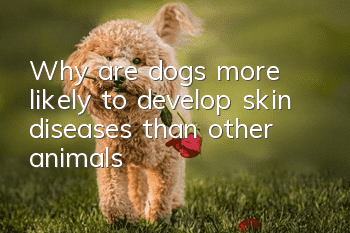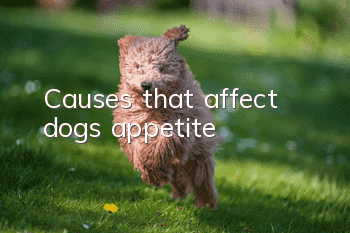Why are dogs more likely to develop skin diseases than other animals?

It is said that there are more than 160 kinds of skin diseases that dogs may be infected with. One vivid saying is that in the medical records of pet doctors, cases related to chronic skin diseases account for 10%. And these cases are also typically the thickest, covering the dog's medical history, lab test results, biopsy reports, medication and supplement use records, and more. This statement reflects two characteristics of skin diseases: multiple occurrence and complexity.
Why are dogs more likely to develop skin diseases than other animals?
The skin thickness of dogs is 0.5-5 mm. The reason why the data fluctuates up and down is because the skin thickness is different in different body parts. Generally speaking, the skin on the back and sides of the body with full hair is the thickest, and the skin on the abdomen is the thinnest. The outermost layer of the skin, the epidermis, which is the first layer that protects the body from various external factors, is only about 0.2-0.5 mm thick. Although the epidermis, in cooperation with coat, keratinocytes and various glands, can provide necessary protection for the body, if the owner chooses enough food and arranges unreasonable living habits, it can easily destroy the health of the skin. state, forming various annoying lesions.
Diet quality affects skin health
On the premise of ensuring healthy skin for dogs, the quality and total amount of protein are very critical. In addition, the important role of certain special amino acids cannot be ignored. For example, cysteine and methionine are high in hair; cysteine, tyrosine, and tryptophan are necessary for skin and coat pigmentation. If these nutrients are lacking, we will see that the dog's coat is dull, rough, sparse, slow to grow or falls off, and the skin flakes increase. There are also effects that we cannot observe, which is the protection of the skin. The ability is reduced, which in turn affects the dog's overall health. In addition to proteins and special amino acids, fats are also important nutrients for skin health, especially the Omega fatty acids contained in some special fats. Omega fatty acids include two major categories. One is Omega3 fatty acids, which are mainly derived from deep-sea fish products. They help reduce skin inflammation related to food allergies, thereby maintaining the health of the skin and cats; the other is Omega6 fatty acids, which are derived from deep-sea fish products. Animal fats and some vegetable oils can help strengthen the immune system to respond to skin infections and injuries, and prevent dry skin.
Certain minerals are also key to ensuring healthy pet skin, chief among them zinc and copper. Zinc is essential for the skin because it participates in physiological and biochemical processes such as skin keratin formation, skin wound healing, vitamin A metabolism, fatty acid synthesis, and immune regulation and response. It also plays an extremely important role in the coloration of skin and hair. It can convert the prokeratin on the skin epidermis into keratin, giving the skin a better barrier function.
Correct care helps the coat to be more beautiful
In addition to internal nutritional conditioning, direct effects on body surface maintenance are also very important. Proper care can help your dog's skin and coat stay healthy. On this issue, the owner should do the following:
1. Groom your dog’s hair regularly. Using the correct comb can help dogs effectively remove dead hair on the body surface, promote blood circulation on the body surface, and ensure the health of the skin;
2. Bathe your dog correctly. We already know that dogs’ skin is different from that of humans, so when bathing dogs, you must follow a pattern that meets their physiological needs. With the help of a professional beautician, use a pet-specific shower gel and set a reasonable bathing frequency. After each bath, be sure to dry the body surface thoroughly, otherwise the remaining moisture on the body surface will be blocked by the coat. The delay in evaporation makes the body surface moist, which can easily form a habitable environment for various fungi, bacteria and parasites;
3. Regularly eliminate external parasites. The presence of parasites itself is a sign of poor skin condition. In addition, parasites may spread other serious diseases and even cause cross-infection between humans and pets, so regular deworming is necessary.
4. Increase exercise time appropriately and increase sunlight exposure time appropriately. This also benefits skin health and a beautiful coat.
Recommended Good Things
Aineng Pet Odor Eliminating Disinfectant can effectively remove body odor/feces odor and other odor molecules! Effective in treating skin diseases caused by fungi/bacteria! Can kill parvovirus/canine distemper virus/coronavirusetc!
It is edible grade for pets, does not contain fragrances, does not contain chemicals, can be sprayed directly, and is harmless to human pets!
Consultation: 13028809308 (WeChat synchronization)
Scan the QR code on WeChat to enter the purchase
- What should dogs eat if they are deficient in trace elements?
- Why do dogs eat shit?
- If a dog bites someone, it’s because he’s not trained, right?
- What is the difference between dog colds and canine distemper? A must-read for dog scrapers!
- What are the differences in hair care for different dogs? Do you know these care methods?
- What should you pay attention to when training your dog?
- When can puppies be weaned from eating dog food?
- What medicine should a dog take if he has a fever?
- How to make your dog’s hair more beautiful, how to beautify and care for your dog’s hair
- Do dogs need to be dewormed frequently? When is the time to deworm dogs?



